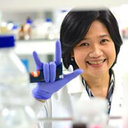Molecular analysis of the genus Asparagus based on matK sequences and its application to identify A. racemosus, a medicinally phytoestrogenic species.
Ключові слова
Анотація
The plant Asparagus racemosus is one of the most widely used sources of phytoestrogens because of its high content of the steroidal saponins, shatavarins I-IV, in roots. The dry root of A. racemosus, known as "Rak-Sam-Sip" in Thai, is one of the most popular herbal medicines, used as an anti-inflammatory, an aphrodisiac and a galactagogue. Recently, the interest in plant-derived estrogens has increased tremendously, making A. racemosus particularly important and a possible target for fraudulent labeling. However, the identification of A. racemosus is generally difficult due to its similar morphology to other Asparagus spp. Thus, accurate authentication of A. racemosus is essential. In this study, 1557-bp nucleotide sequences of the maturase K (matK) gene of eight Asparagus taxa were analyzed. A phylogenetic relationship based on the matK gene was also constructed. Ten polymorphic sites of nucleotide substitutions were found within the matK sequences. A. racemosus showed different nucleotide substitutions to the other species. A polymerase chain reaction-restriction fragment length polymorphism (PCR-RFLP) analysis of the matK gene was developed to discriminate A. racemosus from others. Only the 650-bp PCR product from A. racemosus could be digested with BssKI into two fragments of 397 and 253-bp while the products of other species remained undigested. Ten commercially crude drugs were analyzed and revealed that eight samples were derived from A. racemosus while two samples of that were not. Thus, the PCR-RFLP analysis of matK gene was shown to be an effective method for authentication of the medicinally phytoestrogenic species, A. racemosus.


